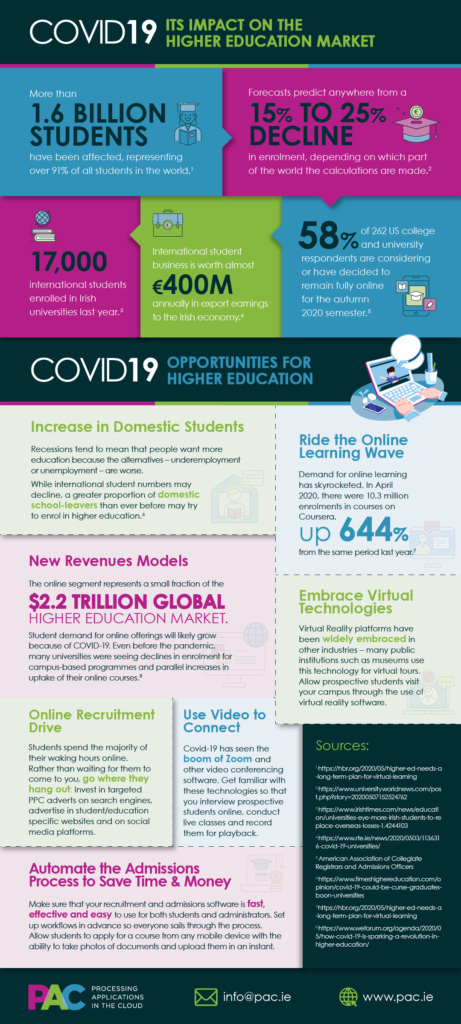Strategies to Help Universities Minimise the Impact of Covid-19 on Higher Education Revenue Streams
COVID-19 has caused a paradigm shift in the academic calendar of educational institutions globally. A recent article in the Harvard Business Review states that “more than 1.6 billion students have been affected, representing over 91% of the entire global student population”. An article on RTE News revealed that factors such as the collapse of international student fee income, rental of on-campus accommodation and commercial revenues is expected to cause major financial setbacks for universities between the financial years 2020 and 2021. The biggest question posing third level institutions across the globe is what the current situation means for student recruitment, admissions and retention in a world that will not return to the old “normal”. This is particularly the case for third level institutions in Ireland and the UK that rely heavily on income from international students.
 The current scenario is forcing educational institutions to think differently to find effective ways to attract new applicants and engage current students through effective online learning. The demand for online learning has skyrocketed over the last few months. In April 2020, there were 10.3 million enrolments in courses on Coursera, up 644% from the same period last year.
The current scenario is forcing educational institutions to think differently to find effective ways to attract new applicants and engage current students through effective online learning. The demand for online learning has skyrocketed over the last few months. In April 2020, there were 10.3 million enrolments in courses on Coursera, up 644% from the same period last year.
Many universities have put in place a system of online workshops, classes, talks and Q&As to enhance their support for students during these unprecedented times. As online learning becomes the new norm moving everything to the cloud is now more crucial than ever. Having the right technology partners that can complement and integrate with current and future systems will be key. Below we have summarised different methods and strategies that third-level institutions can follow to minimise the impact of Covid-19 on student recruitment, admissions and retention.
Recruitment:
Shortfall in the number of international student enrolments
Due to travel and hygiene restrictions that are likely to remain in place for the foreseeable future there have been rising concerns that international students will be unable to travel to the countries they would prefer to study in. Universities will need to work extremely hard to appeal to international applicants given the severe competition in the overseas segment of the student market, known for its potential to generate high revenue.
However, the decline in international student enrolment could lead to more opportunities in the domestic student segment. A greater proportion of domestic school-leavers than ever before may try to enrol in higher education. Additionally, those who find themselves unemployed often seek to upgrade their skills or learn a new discipline – a factor that will increase demand for Postgraduate courses. Institutions can focus on tailoring their admissions efforts to target and appeal to domestic applicants which may help recoup some of the loses from international student revenue.
Focus on online/virtual recruitment drives
As students spend many of their waking hours online, universities should consider investing in targeted PPC adverts on search engines, advertise in student/education specific websites and social media platforms. Embracing virtual technologies to host virtual open days, campus tours & Q&A sessions will allow prospective students to visit your campus using virtual reality software and will greatly add to your online recruitment efforts.
Diversify
Universities can consider altering their business model to include new and expanded course offerings that can be of value to international and domestic students alike. Increased options for online certifications courses, summer courses, short courses for the local community with flexible learning options on a pay-as-you-go model can result in increased enrolment.
Applications:
Automate your admissions process
Investing in a solid student applications portal that is hosted in the cloud, that is easy to use for both administrators and students alike can help your institution save time and money automating the admissions process. PAC Apply’s fast, effective and easy-to-use interface can speed up and simplify the application process by improving prospect data capture, streamline enquiry management and provide seamless applicant support.
Personalise
Adding a “personal touch” when communicating with both current and prospective students could go a long way when it comes to student engagement. A video message from the institution’s Dean/President outlining the rationale behind decisions that are made along with the measures taken by the university to maintain its academic standards and mental well-being of students would be well received. Such personalised marketing content can be branded and promoted across multiple channels (email, web chat, and social media) to generate more awareness and visibility, and help build trust with students and their families.
Retention:
There is no doubt that maintaining student engagement is of utmost importance right now. During these unprecedented times, it is important that third-level institutions remain committed to their values and mission to offer high quality education (no matter the platform) while focusing on the health and well-being of its staff and students.
Focusing on Online engagement
Having a robust IT support system along with a multi-purpose student portal equipped with all the necessary tools and academic resources is essential to support their online learning experience. A strong IT system enables students and staff to readily access academic materials, online lectures, make/view submissions, view timetables and fosters effective communication between fellow students and teachers, all through a centralised repository.
Leveraging the power of video
Covid-19 has seen the boom of Zoom and other video conferencing software which are widely being used for conducting live classes, faculty meetings, student clubs & society meetings and also to interview prospective applicants. Leveraging video and remote meeting tools to deliver trainings, career and academic success workshops can help strengthen engagement and build a strong link between students, the faculty and the institution.
Personalised communications & student support
During these tough times priority needs to be given to making a personal connection with students. As learning moves online, students have less contact with the physical institution which makes it harder for them to access the support and resources they once used and require. As such, it will be important that the faculty provides adequate attention to all their students through constant communication via email, social media and webchat. This will ensure that students feel secure and reassured about their educational journey.
Apart from academic support, institutions will need to provide unrestricted online access to other areas of student support such as counselling services, disability services, virtual support groups and services to promote the mental health and well-being of students. Additional training on leveraging campus technology and software to the maximum can also be given to current and new students. Such services will ensure students are fully supported in a new learning environment.
In conclusion, Covid-19 has had an enormous impact on the global education system almost overnight. Although there are uncertainties and factors that cannot be controlled, it’s not too late for institutions to take the necessary actions to ensure they are best equipped to face the challenges associated with the pandemic. Through forward thinking, a willingness to adopt new technologies and long-term planning; educational institutions can minimise the impact of the pandemic and emerge stronger than before. This is just one step along the journey towards a new educational revolution.

